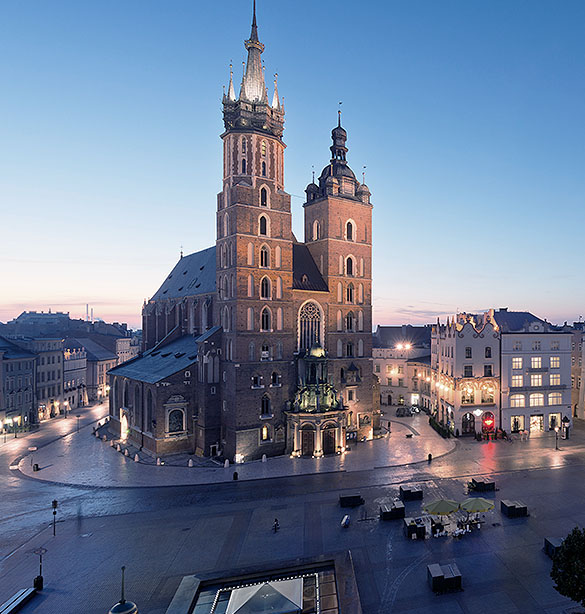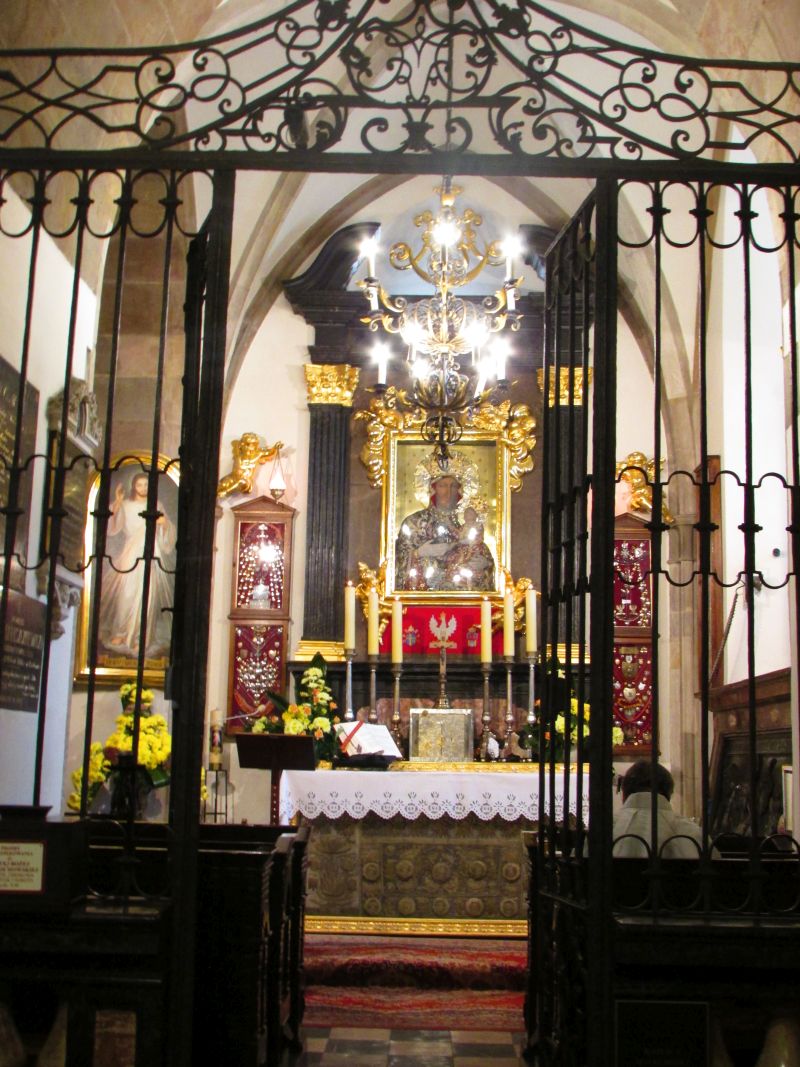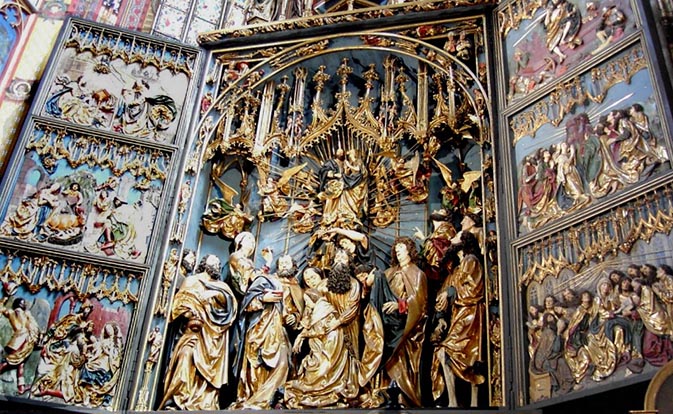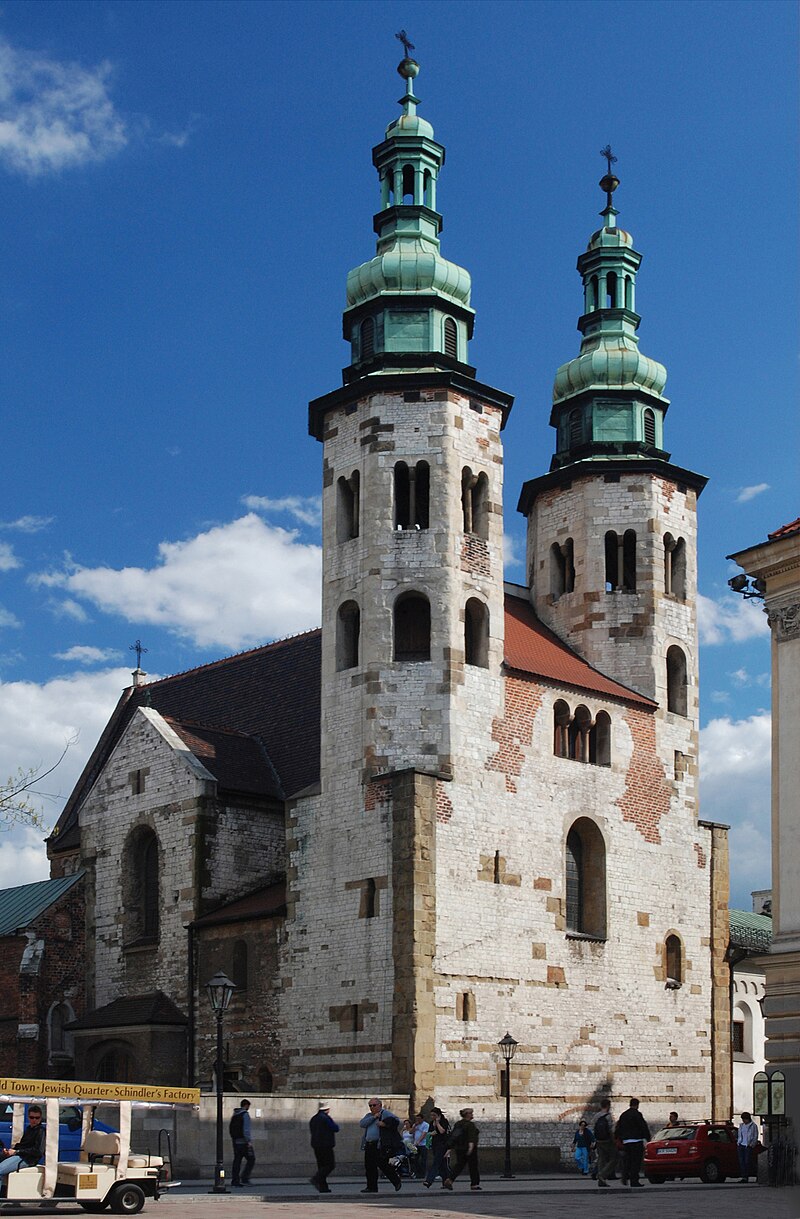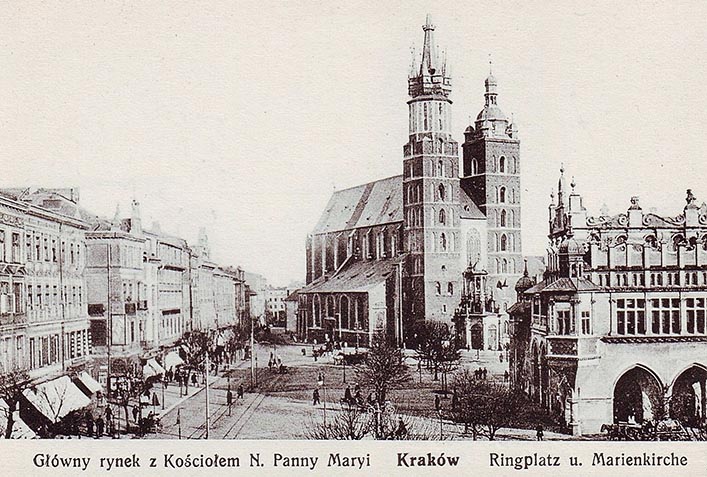 Kościół Mariacki
Kościół Mariacki
We wschodniej części Rynku wznosi się słynny kościół Mariacki, którego pełna nazwa brzmi kościół archiprezbiterialny pw. Wniebowzięcia Najświętszej Marii Panny. W stosunku do osi placu stoi ukośnie, a to dlatego, że istniał już wtedy, gdy wytyczano Rynek w XIII w. Kościół Mariacki od początku był główną świątynią parafialną miasta Krakowa, pozostającą pod mecenatem możnych rodów mieszczańskich. Nie ujmując w niczym randze zgromadzonych w nim dziel sztuki, do dziś zachował swój mieszczańsko-plebejski charakter. W porównaniu z Katedrą Wawelską mniej w nim patosu i ciężaru tradycji. Najsłynniejszym zabytkiem świątyni jest ołtarz Wita Stwosza uważany za najwspanialszy z gotyckich rzeźbionych ołtarzy w Europie. Pod względem artystycznym wielką wartość przedstawiają także: polichromia Jana Matejki, witraże gotyckie, oraz te nowsze, wykonane przez Stanisława Wyspiańskiego i Józefa Mehoffera. Na uwagę zasługują również tablice epitafijne krakowskich patrycjuszy oraz stalle drewniane, będące częścią barokowego wyposażenia świątyni. Pod posadzką kryją się setki trumien bogatych i wpływowych mieszczan, dla których pochówek w podziemiach mariackich byl zaszczytnym finałem ziemskiej wędrówki i podkreślał rangę, jaką cieszyli się za życia. Osobliwością świątyni Mariackiej jest fakt, że większość naprawdę starych sprzętów i dzieł sztuki pozostaje w zasięgu ręki. Można więc zasiąść w stalli, w której zwykł siadać któryś z Bonerów albo sam Matejko. Bliskość w obcowaniu z ołtarzem Stwosza, z dziełami barokowych mistrzów czy nawet z takim drobiazgiem, jak skarbonka XVI-wiecznej mieszczki jest tu bardzo wyraźnie odczuwalna.
Historia
Pierwotny kościół Mariacki zbudowany był z drewna. Kiedy odsłużył swoje, na jego miejscu w latach 1221-1222 postawiono świątynię romańską, o zbliżonych do dzisiejszego kościoła wymiarach, która niestety została zniszczona podczas najazdów tatarskich. Romańskie fundamenty częściowo wykorzystano, gdy w 1290 r. przystąpiono do budowy nowej, ceglanej budowli gotyckiej o dwóch wieżach i trzech nawach równej wysokości (jeśli trzy nawy są równej wysokości, to mamy do czynienia z układem halowym). Od początków swego istnienia był to główny kościół parafialny Krakowa, nad którym mecenat sprawowały możne rody krakowskich patrycjuszy: Bonerów, Montelupich, Salomonów, Bet-manów, Łukowiców, Gałeczków, Moczarskich, Klosowiczów i wielu innych. Król i dwór mieli reprezentacyjną katedrę na Wawelu, krakowianie zaś swój kościół Mariacki. Przez wieki nie szczędzili wysiłków i pieniędzy, aby świątynia była ich dumą i godną wizytówką miasta. Datki od wiernych płynęły szerokim strumieniem: równie hojnie ofiarowywano kosztowności, co zapisywano dobra ziemskie. Nie trzeba było stuleci, aby Mariacki stał się najbogatszym kościołem w Krakowie. Wśród ofiarodawców było mniej więcej tyle samo Polaków co Niemców, dlatego też pod koniec XIV w. wygłaszano kazania w obydwu językach, a nieco później wyłącznie w niemieckim. Sytuacja zmieniła się dopiero w 1537 r., wraz z wyraźną polonizacją mieszczaństwa Krakowa i zdecydowaną polityką biskupstwa krakowskiego. Głoszenie niemieckich kazań przeniesiono wówczas do sąsiedniego kościoła św. Barbary. Do dzisiaj odprawia się tam msze św. w języku niemieckim.
W połowie XIV w., dzięki szczodrobliwości Mikołaja Wierzynka -prominentnego mieszczanina i stolnika sandomierskiego, dobudowano do korpusu kościoła wydłużone prezbiterium. Pod koniec tego samego wieku mistrz Mikołaj Werner przekształcił wnętrze z halowego na bazylikowe (tzn. z nawą główną oświetloną oknami umieszczonymi nad dachami naw bocznych), a w połowie XV w. Franciszek Wiechoń z Kleparza dobudował do zewnętrznych murów naw bocznych kaplice. W tym też czasie zmieniono znacznie wygląd wieży północnej. Działający w wieku XVIII archiprezbiter Jacek Augustyn Łopacki zatarł ślady po gotyku i wprowadził do wnętrza późny barok. Wiek później zlikwidowano egzystujący tuż pod kościołem od zamierzchłych czasów średniowiecza cmentarz parafialny i tak powstał kameralny plac Mariacki. W ostatnim dziesięcioleciu XIX w. wtargnął do świątyni podmuch nowej sztuki, pozostawiając po sobie Matejkowską polichromię oświetlaną po dziś dzień witrażami Wyspiańskiego i Mehoffera.
Decyzja o budowie nowego ołtarza dla kościoła Mariackiego była niezwykle poważnym przedsięwzięciem, świadczącym o zamożności i stabilności ówczesnego mieszczaństwa. Na wykonawcę Rada Miasta wybrała rzeźbiarza Wita Stwosza (1447-1533), pracującego wcześniej prawdopodobnie w Szwabii i Nadrenii. Podobno słówko za nim szepnęli wpływowi bracia wolnomularze, bo i wówczas warto było mieć protekcje, zwłaszcza jeśli w grę wchodziły zamówienia prestiżowe, no i opłacalne – ołtarz kosztował tyle, ile wynosił roczny budżet miasta.
Wit Stwosz urządził sobie przy Grodzkiej pracownie, w której z pomocnikami i uczniami przez dwanaście lat (od 1477 do 1489 r.) pracował nad zamówieniem. Budowę ołtarza kontrolowała specjalna komisja złożona z rajców miejskich. Dnia 25 lipca 1489 r. nastąpiło uroczyste odsłonięcie i poświęcenie mariackiego ołtarza. W parę lat później Stwosz wyjechał na zawsze do Norymbergi, pozostawiając w Krakowie, oprócz syna Stanisława, następujące dzieła: nagrobek Kazimierza Jagiellończyka w katedrze na Wawelu, figurę św. Anny Samotrzeć w kościele Bernardynów, płytę epitafijna Kallimacha w kościele Dominikanów, rzeźbę Chrystusa w Ogrójcu (Muzeum Narodowe) i cudowny krucyfiks w kościele Mariackim. W Norymberdze Wit Stwosz świadczył usługi rzeźbiarskie dla patrycjatu i duchowieństwa, ale nieszczęśliwie wplątany w aferę fałszerską (pośrednio za sprawką Jakuba Bonera) został uwięziony i napiętnowany.
Ponura legenda głosi, że wieże kościoła Mariackiego budowali dwaj bracia architekci. W trakcie pracy jeden z nich wykazał się większym talentem i prześcignął brata, budując wieże wyższą i piękniejszą. Zazdrosny architekt, nie mogąc ścierpieć konkurencji i porażki, wbił nóż w serce swego brata, ale nie mogąc znieść wyrzutów sumienia, rzucił się ze szczytu swej nieudolnej konstrukcji na bruk Rynku Krakowskiego.
